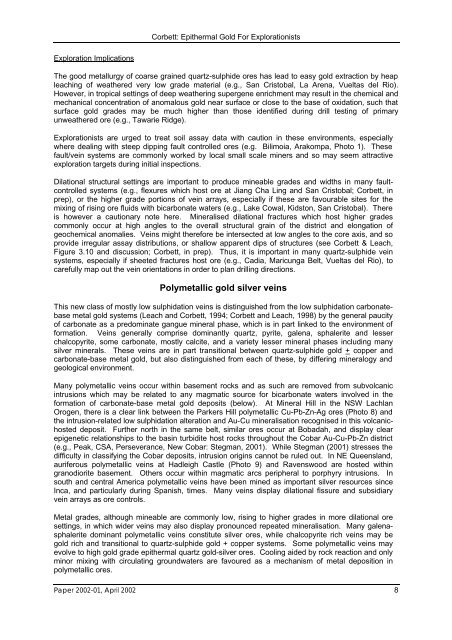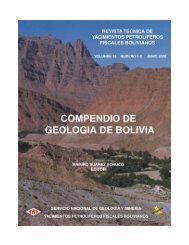Exploraciones por oro epitermal
Create successful ePaper yourself
Turn your PDF publications into a flip-book with our unique Google optimized e-Paper software.
Corbett: Epithermal Gold For Explorationists<br />
Exploration Implications<br />
The good metallurgy of coarse grained quartz-sulphide ores has lead to easy gold extraction by heap<br />
leaching of weathered very low grade material (e.g., San Cristobal, La Arena, Vueltas del Rio).<br />
However, in tropical settings of deep weathering supergene enrichment may result in the chemical and<br />
mechanical concentration of anomalous gold near surface or close to the base of oxidation, such that<br />
surface gold grades may be much higher than those identified during drill testing of primary<br />
unweathered ore (e.g., Tawarie Ridge).<br />
Explorationists are urged to treat soil assay data with caution in these environments, especially<br />
where dealing with steep dipping fault controlled ores (e.g. Bilimoia, Arakompa, Photo 1). These<br />
fault/vein systems are commonly worked by local small scale miners and so may seem attractive<br />
exploration targets during initial inspections.<br />
Dilational structural settings are im<strong>por</strong>tant to produce mineable grades and widths in many faultcontrolled<br />
systems (e.g., flexures which host ore at Jiang Cha Ling and San Cristobal; Corbett, in<br />
prep), or the higher grade <strong>por</strong>tions of vein arrays, especially if these are favourable sites for the<br />
mixing of rising ore fluids with bicarbonate waters (e.g., Lake Cowal, Kidston, San Cristobal). There<br />
is however a cautionary note here. Mineralised dilational fractures which host higher grades<br />
commonly occur at high angles to the overall structural grain of the district and elongation of<br />
geochemical anomalies. Veins might therefore be intersected at low angles to the core axis, and so<br />
provide irregular assay distributions, or shallow apparent dips of structures (see Corbett & Leach,<br />
Figure 3.10 and discussion; Corbett, in prep). Thus, it is im<strong>por</strong>tant in many quartz-sulphide vein<br />
systems, especially if sheeted fractures host ore (e.g., Cadia, Maricunga Belt, Vueltas del Rio), to<br />
carefully map out the vein orientations in order to plan drilling directions.<br />
Polymetallic gold silver veins<br />
This new class of mostly low sulphidation veins is distinguished from the low sulphidation carbonatebase<br />
metal gold systems (Leach and Corbett, 1994; Corbett and Leach, 1998) by the general paucity<br />
of carbonate as a predominate gangue mineral phase, which is in part linked to the environment of<br />
formation. Veins generally comprise dominantly quartz, pyrite, galena, sphalerite and lesser<br />
chalcopyrite, some carbonate, mostly calcite, and a variety lesser mineral phases including many<br />
silver minerals. These veins are in part transitional between quartz-sulphide gold + copper and<br />
carbonate-base metal gold, but also distinguished from each of these, by differing mineralogy and<br />
geological environment.<br />
Many polymetallic veins occur within basement rocks and as such are removed from subvolcanic<br />
intrusions which may be related to any magmatic source for bicarbonate waters involved in the<br />
formation of carbonate-base metal gold deposits (below). At Mineral Hill in the NSW Lachlan<br />
Orogen, there is a clear link between the Parkers Hill polymetallic Cu-Pb-Zn-Ag ores (Photo 8) and<br />
the intrusion-related low sulphidation alteration and Au-Cu mineralisation recognised in this volcanichosted<br />
deposit. Further north in the same belt, similar ores occur at Bobadah, and display clear<br />
epigenetic relationships to the basin turbidite host rocks throughout the Cobar Au-Cu-Pb-Zn district<br />
(e.g., Peak, CSA, Perseverance, New Cobar: Stegman, 2001). While Stegman (2001) stresses the<br />
difficulty in classifying the Cobar deposits, intrusion origins cannot be ruled out. In NE Queensland,<br />
auriferous polymetallic veins at Hadleigh Castle (Photo 9) and Ravenswood are hosted within<br />
granodiorite basement. Others occur within magmatic arcs peripheral to <strong>por</strong>phyry intrusions. In<br />
south and central America polymetallic veins have been mined as im<strong>por</strong>tant silver resources since<br />
Inca, and particularly during Spanish, times. Many veins display dilational fissure and subsidiary<br />
vein arrays as ore controls.<br />
Metal grades, although mineable are commonly low, rising to higher grades in more dilational ore<br />
settings, in which wider veins may also display pronounced repeated mineralisation. Many galenasphalerite<br />
dominant polymetallic veins constitute silver ores, while chalcopyrite rich veins may be<br />
gold rich and transitional to quartz-sulphide gold + copper systems. Some polymetallic veins may<br />
evolve to high gold grade epithermal quartz gold-silver ores. Cooling aided by rock reaction and only<br />
minor mixing with circulating groundwaters are favoured as a mechanism of metal deposition in<br />
polymetallic ores.<br />
Paper 2002-01, April 2002 8
















